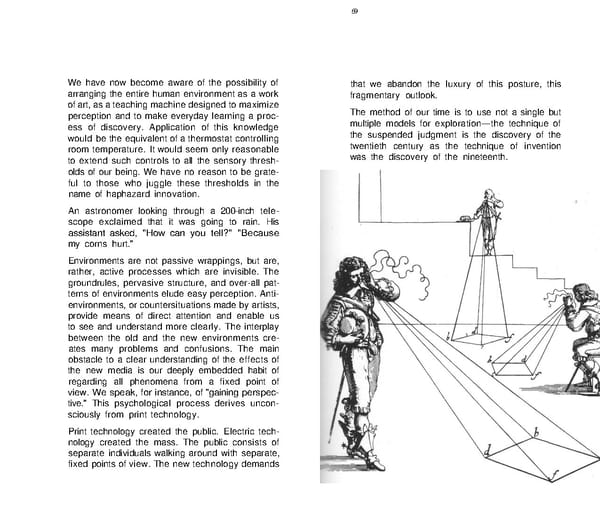69 We have now become aware of the possibility of that we abandon the luxury of this posture, this arranging the entire human environment as a work fragmentary outlook. of art, as a teaching machine designed to maximize The method of our time is to use not a single but perception and to make everyday learning a proc multiple models for exploration—the technique of ess of discovery. Application of this knowledge the suspended judgment is the discovery of the would be the equivalent of a thermostat controlling twentieth century as the technique of invention room temperature. It would seem only reasonable was the discovery of the nineteenth. to extend such controls to all the sensory thresh olds of our being. We have no reason to be grate ful to those who juggle these thresholds in the name of haphazard innovation. An astronomer looking through a 200inch tele scope exclaimed that it was going to rain. His assistant asked, "How can you tell?" "Because my corns hurt." Environments are not passive wrappings, but are, rather, active processes which are invisible. The groundrules, pervasive structure, and overall pat terns of environments elude easy perception. Anti environments, or countersituations made by artists, provide means of direct attention and enable us to see and understand more clearly. The interplay between the old and the new environments cre ates many problems and confusions. The main obstacle to a clear understanding of the effects of the new media is our deeply embedded habit of regarding all phenomena from a fixed point of view. We speak, for instance, of "gaining perspec tive." This psychological process derives uncon sciously from print technology. Print technology created the public. Electric tech nology created the mass. The public consists of separate individuals walking around with separate, fixed points of view. The new technology demands
 The Medium Is The Massage - Marshall McLuhan Page 38 Page 40
The Medium Is The Massage - Marshall McLuhan Page 38 Page 40